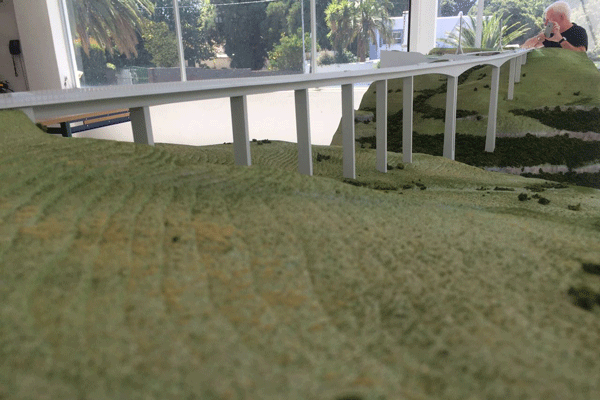 Bridges have fascinated people through the centuries; their purpose is self-evident as being the link between transportation routes be they footpaths, railways or roads. Although its primary purpose is functional and it must be safe to use, a bridge can be a thing of beauty.
Bridges have fascinated people through the centuries; their purpose is self-evident as being the link between transportation routes be they footpaths, railways or roads. Although its primary purpose is functional and it must be safe to use, a bridge can be a thing of beauty.
Some of the world’s bridges have become tourist attractions in their own right; the Golden Gate Bridge in San Francisco, Sydney Harbour Bridge in Australia and Millau Viaduct in France are just a few examples. People are especially fascinated by large bridges.
Of South Africa’s 750 000km of highway, some 22 000 falls under the jurisdiction of the South African National Roads Agency, SANRAL, which includes approximately 9 500 bridges and major culverts.
Two spectacular bridges on the new N2 Wild Coast Highway – the Msikaba River Bridge and the Mtentu River Bridge –– are about to be added. The first steps towards making this a reality were taken recently in inviting tenders for the two bridges. Apart from making a major contribution to transport infrastructure and to the well-being of the people who live along the new Greenfields portion of N2 which is about 113km in length, the bridges will be true landmarks of international note. In searching for safe and economical designs Sanral has also driven the need for aesthetic designs that will act as positive landmarks for the new highway. It is our view that this aim was achieved in that a good balance was struck between economy and aesthetics in the final solutions that were adopted.
The designs of the bridges are complete and tenders have been invited. Due to the size and complexity of the two bridges, the tender process will only be completed early in 2017 and construction is programmed to begin in the middle of 2017.
The Msikaba River Bridge will be 580m single span cable-stayed bridge. The bridge is a unique spectacular structure that crosses a deep forested gorge which is flanked on each side with high sandstone cliffs. At no stage will work be done in the gorge and the deck will be cantilevered out from the banks using conventional construction techniques. The bridge is 190m above the river and the bridge erection team will undoubtedly presented with some challenging weather conditions. The deck is a composite steel and concrete deck of overall width of 22.8m. Four traffic lanes with narrow shoulders are provided for and two 1.4m wide pedestrian footway. This bridge will be the largest span cable-stayed bridge in South Africa.
Some 18km north of the Msikaba River is the proposed Mtentu River Bridge. The deck of this bridge is some 220m above the river and it will be a 1 132m-long concrete structure with a balanced cantilever main span of 260m with depth of deck varying from 15m at the piers to 5m at the centre. The approach spans of the bridge will be incrementally launched and consist of 66m-long spans with a constant depth of 5m. The two piers supporting the balanced cantilever portion of the deck will be 154m high and the bridge will be a wholly prestressed concrete bridge with an overall width of 20.1m. Four traffic lanes with narrow shoulders will be provided and two 1.4m-wide pedestrian footways. This bridge will be one of only a few such large concrete balanced cantilever bridges with spans of 260m or more in the world.
The bridges and the overall highway project will be a catalyst for local development, bringing direct and indirect business opportunities, boosting small and medium enterprises while connecting local communities with each other as well as bigger towns along the road. It will also make the Wild Coast tourist attractions more accessible.
Both structures with their clean, functional lines are also expected to become tourist attractions and will be complemented by the natural beauty of the area. Visitors who stop to view the bridges will also see the natural beauty of the valleys they cross. Pedestrian walkways with safety screens will be provided along both sides of each bridge and they will be fully accessible to allow everyone to view the magnificent valleys from the bridges. In addition viewing sites will be built nearby so that the public can view the bridges and admire the natural beauty of their settings.
As with all Sanral bridges, safety, aesthetic and environmental issues play a major role in the planning, the design phases and the future construction phases of the Msikaba and Mtentu bridges. This will be the case for all the highways and bridges on the Wild Coast Highway, where the protection of the environment has featured strongly.
The future inspection and maintenance of the bridges will be incorporated in the overall bridge inspection routine at Sanral. Durable concrete has been specified to minimise future maintenance and the design of the bridges followed South African bridge design codes which have their basis in international codes. Where the South African codes do not cover any particular aspect of design, international codes are used instead.
The construction of these two new bridges and the Greenfields section of the highway will bring economic benefits to the Eastern Cape as well as the transport benefits from reducing the travel distance between the major cities of Durban and East London by 75km. This will bring benefits to the local economy as well as the national economy and major tourist destinations will be more easily accessible.
Written by Edwin Kruger, the bridge network manager of the South African National Roads Agency Limited.


